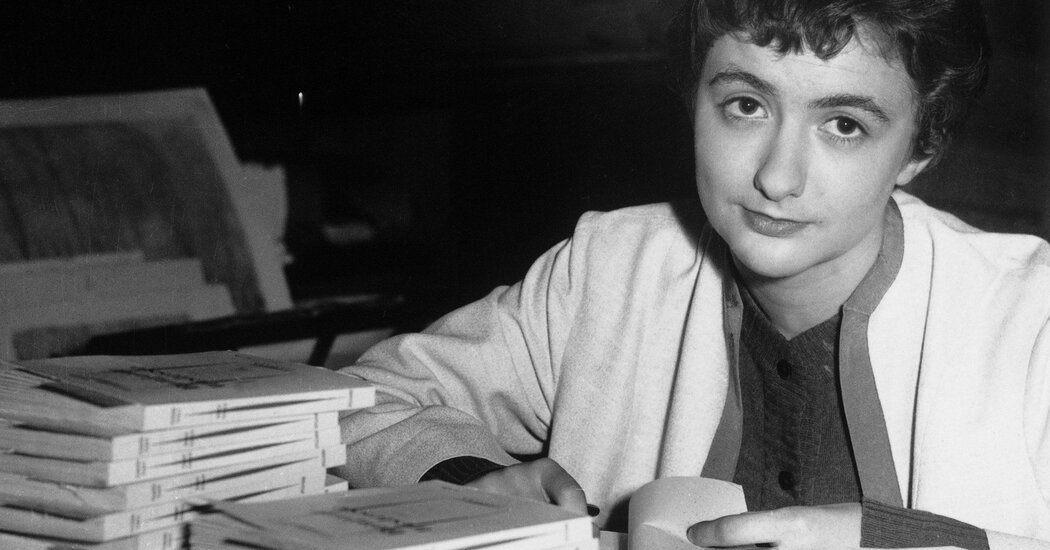“Childhood is an image, which we decorate,” Françoise Sagan wrote in her autobiography, “Réponses.”
Ms. Sagan, born Françoise Delphine Quoirez, was only 18 when her first novel, “Bonjour Tristesse,” published in 1954, caused a sensation across the globe. But she was not just a literary wunderkind: The teenage author became an object of worldwide press fascination (Pope Paul VI denounced the novel as “an example of irreligosity”), and the caricature of those years would haunt her.
From the get-go, many recognized Ms. Sagan as a genuine talent, with critics likening her to the fellow literary enfant terrible Colette. In Le Figaro, the French novelist François Mauriac called her a “charming monster,” but conceded that “talent bursts on the first page. This book has all the ease, all the audacity of youth without having the slightest vulgarity.” The philosopher Jean-Paul Sartre deemed her the real thing, and “Bonjour Tristesse” went on to win the Prix des Critiques in 1954.
While the author’s own life encompassed the full spectrum of adult tragedies and pleasures — as well as 20 books — in the popular American imagination, her image seems curiously bound up with youth: “it” girl; French girl. Today, we might add “nepo baby” because of her parents’ social connections — her father was a prosperous industrialist, her mother from an old landowning family.
Naturally, this reputation conferred skepticism. (The fact that by age 21 her father had managed her earnings into a tidy fortune could not have helped.) There were those who were not shocked, yet unimpressed by what they regarded as a pampered daughter of the bourgeoisie, with middling talent and a great publicist. (This paper dismissed Ms. Sagan, calling “Bonjour Tristesse” an “immature little novel, mainly a catalogue of moods experienced under the strain of a father-complex by a fairly precocious French girl.” )
“My feeling is that she represents something important in the French literary and cultural imagination,” said the novelist Tash Aw. “There’s also something about the setting of ‘Bonjour Tristesse’ that is so quintessentially French that it stays in the popular imagination even if people have never read the book.”
The book is the story of a teenage girl and one eventful summer in the south of France, a coming-of-age novel that combines cleareyed insight with a vivid evocation of youth. The mixture of the well-educated bourgeois schoolgirl — Ms. Sagan took her pen name from Proust and her debut’s title from Paul Valery — and frank discussion of adultery proved a potent combination. In a rapidly changing France, readers thrilled to a novel that expressed the ambivalence of generational shift; the rest of the world, long obsessed with a dynamic stereotype of French sophistication, was equally entranced by this prototypical, modern, politically engaged French girl.
First adapted for the screen by Otto Preminger in 1958, the film starred David Niven and Jean Seberg, forever conflating the author in the public imagination with the artless allure — and iconic haircut — of Ms. Seberg. A new adaptation was released this month, helmed by Durga Chew-Bose in her directorial debut — with the blessing of the author’s son, Denis. “Some people told us we were adapting their national anthem,” Ms. Chew-Bose said.
Throughout her career, Ms. Sagan was defiant, facing interviewers with a brittle sophistication. “All my life, I will continue obstinately to write about love, solitude and passion among the kind of people I know,” she told an interviewer for The Transatlantic Review. “The rest don’t interest me.” These kinds of people would come to include louche luminaries like Truman Capote and Ava Gardner. Indeed, to her critics, the spigot of novels, plays, memoir, pop song lyrics and screenplays may have had more than a whiff of the dilettantish.
“I think that feeling of being very young and utterly world-weary is both a recipe for chic and, to use a word I hate, relatable,” said the writer and translator Leslie Cahmi. “Of feeling one’s way blindly and realizing that the adults are just as lost as you are. Sagan’s postwar French prosperity is haunted by a faint perfume of existentialist desperation.”
Ms. Sagan certainly seemed to capture something: the jaded French bourgeoisie, in love, surrounded by interiors and style. Her books paint a vivid picture of a milieu she knew intimately. And in a world before autofiction, her best writing had tight and disciplined plotting. “Nothing is more unreal than certain so-called realist novels — they’re nightmares,” she told The Paris Review.
To the author Claire Messud, “Bonjour Tristesse” — and the furor surrounding its young author — spoke to larger cultural tendencies: “French culture’s intense desire, tendency (at that time at least, in the ’50s) to celebrate adolescent female brilliance, however briefly.”
Car crashes, youthful divorces from playboys, multiple affairs of variable happiness and substance abuse took their toll. Ms. Sagan was, the critic Bertrand Poirot-Delpech commented with relish, “a bird fallen from the nest on which modern cannibalism cut its teeth and won’t give up.” She found contentment and stability with the fashion stylist Peggy Roche, but after Ms. Roche’s death she once again struggled with substance abuse; she died at 69 from a pulmonary embolism.
But somehow the timelessness of “Bonjour Tristesse” — and perhaps, the legend of its author — endures, urgent and relevant. As Ms. Chew-Bose put it, “I think any story told from the pod of a young woman trying to sort through the turmoil of coming-of-age will always feel modern to me.”
